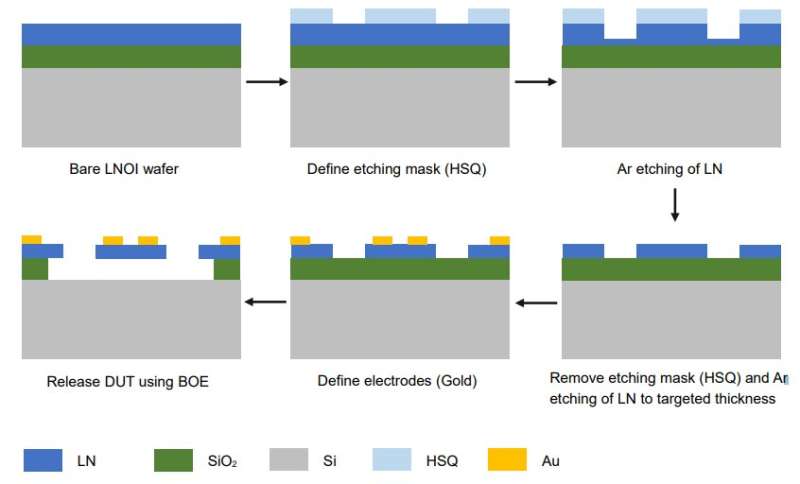This article has been reviewed according to Science X's editorial process and policies. Editors have highlighted the following attributes while ensuring the content's credibility:
fact-checked
peer-reviewed publication
trusted source
proofread
First electromechanical resonator to operate beyond 100 GHz

In what has the potential to significantly advance wireless communications and mechanical quantum systems, researchers at Yale have demonstrated the world's first electromechanical resonator to operate beyond 100 GHz.
Conducted in the lab of Hong Tang, the Llewellyn West Jones, Jr. Professor of Electrical Engineering, Applied Physics & Physics, the results of the work are published in Nature Electronics.
Developing resonators with higher operating frequencies is an ongoing goal within the electronics field. That's because the higher the frequency, the faster the speed of communication. Getting resonators to operate within the sub-terahertz (THz) regime—that is, between 100 and 300 gigahertz (GHz)—is a particularly sought-after target.
"Going to higher frequencies is always a goal for us, because it makes the communication faster," said Jiacheng Xie, a Ph.D. student in Tang's lab, and lead author of the study. "So going to sub-terahertz—in this case, to 100 GHz—brings a whole lot more bandwidth for future communication devices."
Tang noted that this might be the most significant technological impact of the work. Electromechanical resonators of higher and higher frequencies are the "behind-the-scenes drivers" in wireless communications.
"Mechanical resonators working beyond 100GHz was unthinkable before this work," he said. "This is a true milestone to celebrate."
Such resonators are also of interest in studying quantum phenomena of mechanical entities, as they can maintain the quantum ground state at kelvin temperatures rather than the millikelvin temperatures demanded by gigahertz resonators.
"Going into higher frequencies means that our resonators are more resilient to thermal noise, and that means that we don't have to cool the resonators down to millikelvin," Xie said.
Xie noted that few instruments can go to such a high frequency, adding that the signal generators in most labs can only support a frequency much lower than 100 GHz.
"To review the very small signals at such high frequency, we have to adopt particular designs to achieve that," he said. "In this work, we use a millimeter-wave resonator that is incorporated into a suspended lithium niobate platform, which can provide the efficient electromechanical transduction in the sub-terahertz regime. And without it, it would not be easy at all."
More information: Jiacheng Xie et al, Sub-terahertz electromechanics, Nature Electronics (2023). DOI: 10.1038/s41928-023-00942-y



















